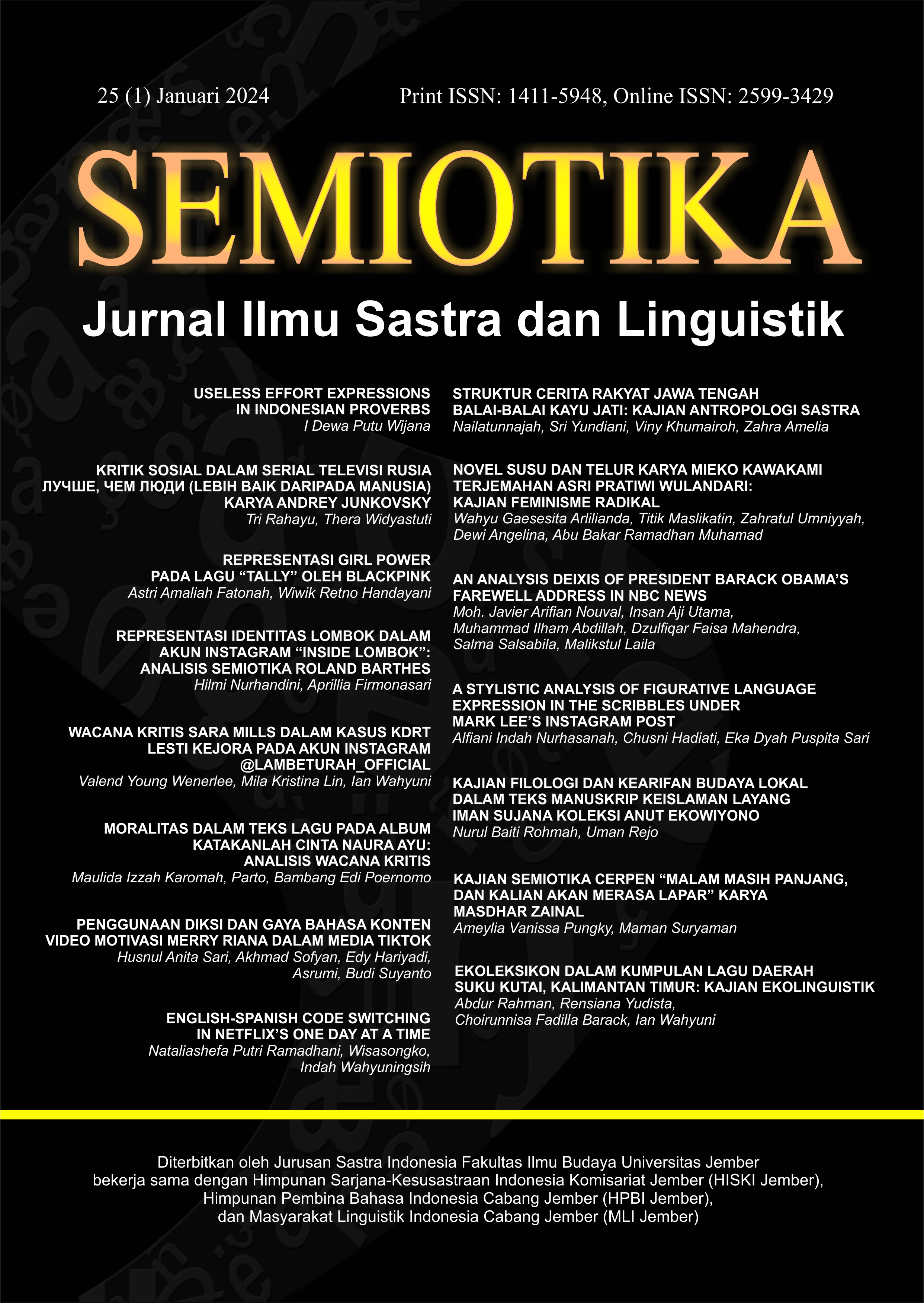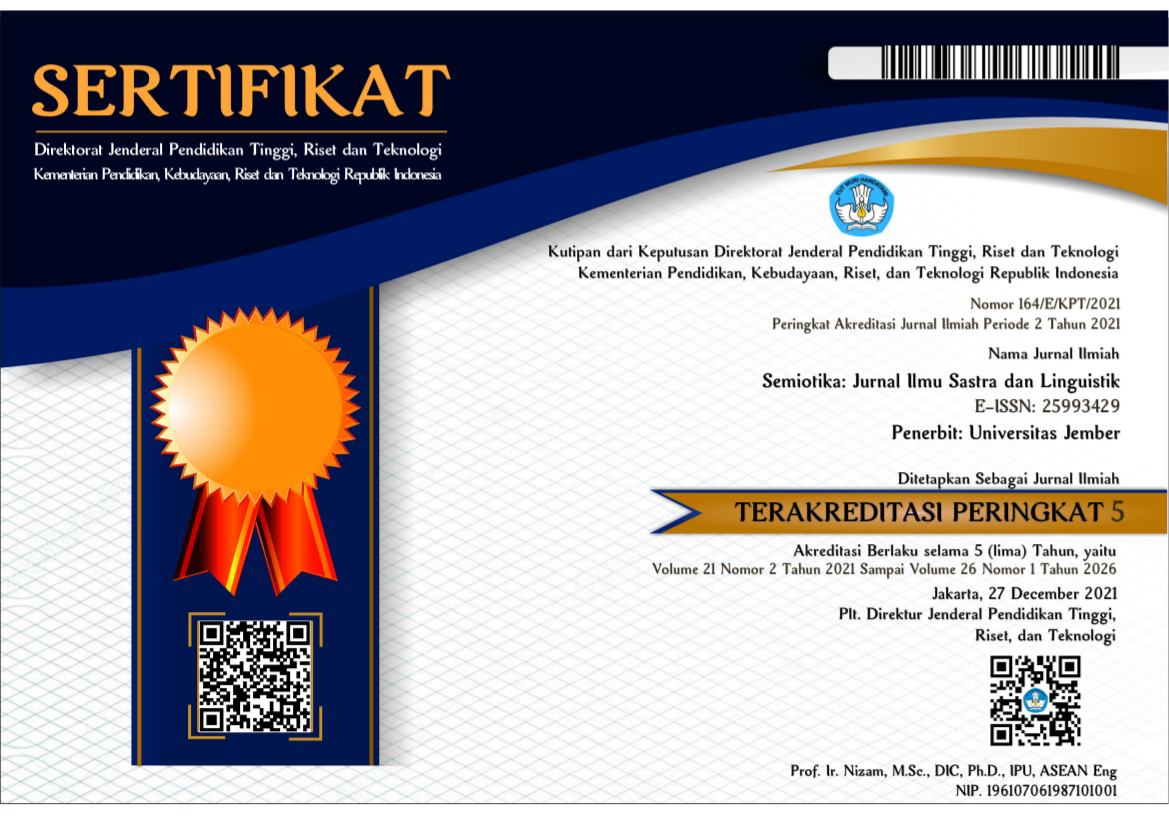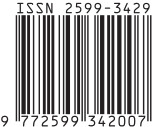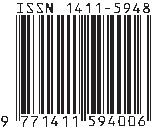USELESS EFFORT EXPRESSIONS IN INDONESIAN PROVERBS
Abstract
This research article deals with Indonesian proverbs used to express “useless efforts” with focus of attention on the syntactic structures, and various causal factors that make the works expressed by the verbs impossible to realize. By using data collected from proverb collection book entitled 7700 Perribahasa Indonesia [7700 Indonesian Proverbs], it is found that the Indonesian proverbs convey useless efforts can be delivered through various types of syntactic structure: predicate-object (PO), conjunction-predicate-object (Conj-P-O), predicate-object-adverbial (P-O-Adv), conjunctionpredicate-object-adverbial (Conj-P-O-Adv), predicate-complement (P-Comp), predicate-adverbial (P-Adv), conjunction-predicate-adverbial (Conj-P-Adv), subject-predicate-object (S-P-O), subjectpredicate-adverbial (S-P-Adv), conjunction-predicate-adv (Conj-P-Adv), predicate-subject (P-S), and adverbial-subject-predicate (Adv-S-P). Based on these various types of structure, in the proverbs involving no subject slot, the impossibilities can be caused by the objects, object attributes, complements, and adverbials that explain the location, time, purpose, and instrument by which the efforts are executed. Meanwhile, in the proverbs involving subject constituent, the impossibilities are caused by the subjects filled by words or phrases of having referents human, non human, or entities which are improper or incapable realizing the actions.
References
Arimi, S. 2016. “Peribahasa Indonesia: Kajian Kategorisasi, Struktur, dan Vitalitasnya.” Yogyakarta: Fakultas Ilmu Budaya Universitas Gadjah Mada.
Halliday, M.A.K. 1975. Learning How to Mean: Exploration in The Development of Language. London: Edward Arnold.
Hendrokumoro, 2017. “Peribahasa Jawa.” Disertasi. Yogyakarta: Fakultas Ilmu Budaya Universitas Gadjah Mada.
Hornby, H.S. 2015. Oxford Advanced Learner’s Dictionary of Current English. Oxford University Press.
Indrawati, S. 2019. “Student’s Understanding on Proverbs: Studies of Learning in School”. The 28th International Conference on Literature, July 11—13. Banda Aceh: Syah Kuala University.
Kinanti, S.P. 2021. “Metafora Gajah dalam Peribahasa Indonesia”. Medan Bahasa. 15(1).
Mulatabi, M.M.Al. 2019. “Exploring The Significance of Proverb in English Language”. Al Suna: Juornal of Arabic and English Language. 2(1):30—38. https://doi.org/1031538/alsuna.2i1.298.
Neupane, N. 2021. “Cultural Translations of Nepali Proverbs into English”. Journal on Language and Language Teaching, 24 (2). Doi:https://doi.org/10.24071/Lit.v24i7.
Siregar, B.U. 2011. Seluk Beluk Fungsi Bahasa. Jakarta: Pust Kajian Bahasa dan Budaya Universitas Katolik Indonesia Atmajaya.
Sudiran. 2007. “The Role of English Proverbs in the Development of Writing Skill”. Celt: A Journal of Culture, English Language Teaching, and Literature, 7(2). https://doi.org./1024167/celt.v7.12.
Syarfuni. 2014. “An Analysis of English Idioms and Indonesian Proverbs”. Getsempena English Education Journal, 1(1).
Syzdykov, K. 2014. “Contrastive Studies on Proverbs”. Procedia: Social and Behavioral Sciences, 136 (318—321).
Wardaugh, R. 1988. An Introduction of Sociolinguistics. Basil Blackwell.
Wijana, I D.P. 2022. “Target Domains of Water in Indonesian Proverbs”. Linguistic Issues: A Compilation of Working Papers. Yogyakarta: TS Publisher.
Wijana, I D.P. 2023.Target Domains of Ayam ‘Chicken’ in Indonesian Proverbs. Linguistic Issues 2: A Compilation of Working Papers. Yogyakarta: Pustaka Larasan.

This work is licensed under a Creative Commons Attribution-ShareAlike 4.0 International License.
SEMIOTIKA has CC-BY-SA or an equivalent license as the optimal license for the publication, distribution, use, and reuse of scholarly work. Authors who publish with this journal retain copyright and grant the journal right of first publication with the work simultaneously licensed under a Creative Commons Attribution-ShareAlike 4.0 International License that allows others to share the work with an acknowledgment of the work's authorship and initial publication in this journal.
Attribution-ShareAlike
CC BY-SA










